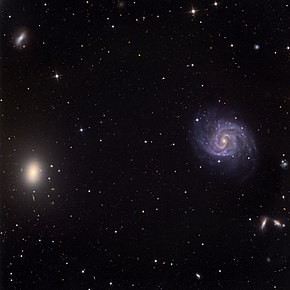NGC 1052 is an elliptical galaxy in the constellation Cetus. It was discovered on January 10, 1785 by the astronomer William Herschel.[3] It is a member of the eponymous NGC 1052 Group.[1]
| NGC 1052 | |
|---|---|
 NGC 1052 (center left) and NGC 1042 (center right) as imaged by Schulman Telescope | |
| Observation data (J2000 epoch) | |
| Right ascension | 02h 41m 04.79851s[1] |
| Declination | −08° 15′ 20.7517″[1] |
| Redshift | 0.004930[1] |
| Heliocentric radial velocity | 1474 ± 26 km/s[1] |
| Distance | 62.0 Mly (19.00 Mpc)[2] |
| Group or cluster | NGC 1052 Group[1] |
| Apparent magnitude (V) | 10.47[2] |
| Apparent magnitude (B) | 11.41[2] |
| Characteristics | |
| Type | E4[2] |
| Apparent size (V) | 3.0′ × 2.1′[2] |
| Other designations | |
| MCG -01-07-034, PGC 10175[1] | |
Features
NGC 1052 is located at a distance of around 63 million light years from the Milky Way,[4] and has a LINER-type active galactic nucleus which signals the intense starburst activity in the galaxy's center[5] that were confirmed with observations with better resolution showing a number of star-forming regions and young star clusters.[6]
NGC 1052 shows also two small jets emerging from its nucleus as well as a very extended disc of neutral hydrogen, far larger than the galaxy itself.[7] Additionally, the stars and the ionized gas rotate along different axes.[8] All these features suggesting a gas-rich galaxy collided and merged with it 1 billion years ago producing all the above features.[6]
The shape of NGC 1052 is thought to be a triaxial ellipsoid. The longest axis of the ellipsoid is probably aligned at a position angle of −41°, which is the axis around which the ionized gas would be rotating.[8]
A scale image of NGC 1052 and its satellite galaxies is available at the reference.[9]
Central black hole
NGC 1052 hosts a rapidly rotating supermassive black hole with a mass of 154 million M☉[10] with a large magnetic field of between 0.02 and 8.3 Tesla, which, according to PhD student Anne-Kathrin Baczko, the leader of the team that made this discovery, provides enough magnetic energy to power the previously mentioned twin relativistic jets.[11]
The location of this black hole is the most precisely known in the universe, with the exception of Sagittarius A*, the supermassive black hole found at the heart of our own galaxy.[11]
See also
- NGC 1052-DF2, a galaxy assumed to be associated with NGC 1052, and which appears to have little or no dark matter
- NGC 1052-DF4, another galaxy assumed to be associated with NGC 1052, and which appears to have little or no dark matter[12]
References
External links
 Media related to NGC 1052 at Wikimedia Commons
Media related to NGC 1052 at Wikimedia Commons
